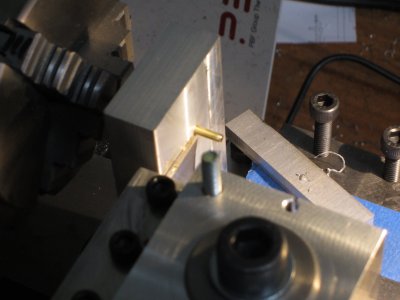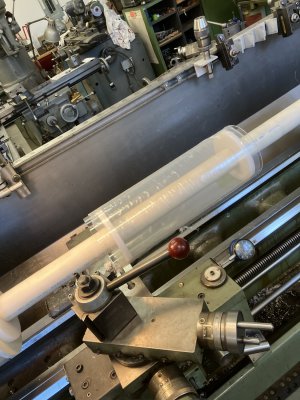- Joined
- Jul 28, 2017
- Messages
- 2,383
I need to make about 10 metal sleeves from 2.5mm OD thin-wall brass tubing. I made a custom travelling rest to support the tubing, so I can position my parting tool right where the tubing exits the rest (see photo below).

The hole is just a little larger than the tubing. My question is about the height of my parting blade. For this kind of situation is it best to have the blade slightly high, low, or dead-center on the tubing?
One refinement I'm thinking about is making a piece with a V groove in it, to support the tubing a little better. The piece would be run up to the tubing and fixed with a couple of screws. I _could_ mill a step in my vertical block, but I have some other plans for this thing once I'm done making my brass sleeves.
BTW I initially just positioned my parting tool very close to the chuck jaws but its 3-point grip didn't provide enough support for the tubing -- the ends of the tubing became deformed. These sleeves need to slip over a small post and there isn't much clearance. I was forced to ream out the ends of the tubing, not easy to do with a .250" long piece of 2.5mm tubing. That got old pretty quickly.

The hole is just a little larger than the tubing. My question is about the height of my parting blade. For this kind of situation is it best to have the blade slightly high, low, or dead-center on the tubing?
One refinement I'm thinking about is making a piece with a V groove in it, to support the tubing a little better. The piece would be run up to the tubing and fixed with a couple of screws. I _could_ mill a step in my vertical block, but I have some other plans for this thing once I'm done making my brass sleeves.
BTW I initially just positioned my parting tool very close to the chuck jaws but its 3-point grip didn't provide enough support for the tubing -- the ends of the tubing became deformed. These sleeves need to slip over a small post and there isn't much clearance. I was forced to ream out the ends of the tubing, not easy to do with a .250" long piece of 2.5mm tubing. That got old pretty quickly.


